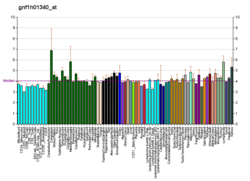| OR1I1 |
|---|
|
| Identifiers |
|---|
| Aliases | OR1I1, OR19-20, OR1I1P, OR1I1Q, olfactory receptor family 1 subfamily I member 1 |
|---|
| External IDs | MGI: 3031191; HomoloGene: 72920; GeneCards: OR1I1; OMA:OR1I1 - orthologs |
|---|
| Gene location (Human) |
|---|
 | | Chr. | Chromosome 19 (human)[1] |
|---|
| | Band | 19p13.12 | Start | 15,082,211 bp[1] |
|---|
| End | 15,092,970 bp[1] |
|---|
|
| Gene location (Mouse) |
|---|
 | | Chr. | Chromosome 10 (mouse)[2] |
|---|
| | Band | 10|10 C1 | Start | 78,446,837 bp[2] |
|---|
| End | 78,453,908 bp[2] |
|---|
|
| RNA expression pattern |
|---|
| Bgee | | Human | Mouse (ortholog) |
|---|
| Top expressed in | - tibialis anterior muscle
- gonad
- mucosa of ileum
- testicle
- deltoid muscle
- skin of hip
- skin of thigh
- placenta
- blood
- gastric mucosa
|
| | Top expressed in | - respiratory epithelium
- nasal epithelium
- olfactory epithelium
- olfactory bulb
|
| | More reference expression data |
|
|---|
| BioGPS |  | | More reference expression data |
|
|---|
|
| Gene ontology |
|---|
| Molecular function | - G protein-coupled receptor activity
- signal transducer activity
- transmembrane signaling receptor activity
- olfactory receptor activity
| | Cellular component | - integral component of membrane
- plasma membrane
- membrane
| | Biological process | - response to stimulus
- signal transduction
- sensory perception of smell
- detection of chemical stimulus involved in sensory perception of smell
- detection of chemical stimulus involved in sensory perception
- G protein-coupled receptor signaling pathway
| | Sources:Amigo / QuickGO |
|
| Orthologs |
|---|
| Species | Human | Mouse |
|---|
| Entrez | | |
|---|
| Ensembl | | |
|---|
| UniProt | | |
|---|
| RefSeq (mRNA) | | |
|---|
| RefSeq (protein) | | |
|---|
| Location (UCSC) | Chr 19: 15.08 – 15.09 Mb | Chr 10: 78.45 – 78.45 Mb |
|---|
| PubMed search | [3] | [4] |
|---|
|
| Wikidata |
| View/Edit Human | View/Edit Mouse |
|

















